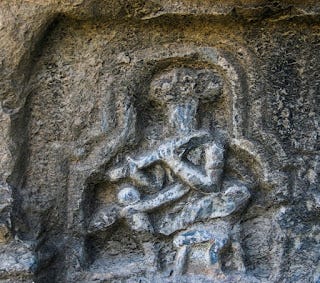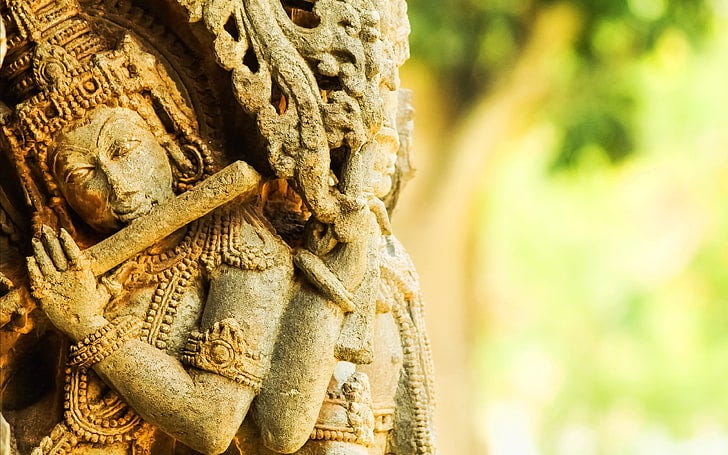#9: Bānsuri & Ghata | Story of two unique yet similar instruments
In posts #7 and #8 we have seen how in Indian sculpture and poetry, the Bānsuri and the Ghata are portrayed as a metaphor for the sharīra, the human body. What makes these two instruments similar? Considering they are fundamentally different from each other - one melodic and another rhythmic? In this post, we look at the history and the evolution of Bānsuri and the Ghata, the incredible connections shared by them and also what makes them so special. These observations are based on my brief interaction with the contemporary Ghatam maestro Shri Giridhar Udupa and my Bānsuri Guru Shri Jayateerth Kulkarni.
A shared history: From folk to classical
Bānsuri (Indian bamboo flute) and the Ghata (an earthen pot) are probably the oldest known musical instruments in India. They are seen everywhere from Indian literature to iconography for at least a couple of millennia, and as we have seen in the previous two posts, they are used as a metaphor by Indian philosophical traditions to refer to the human body in particular but the universe in general, because these two instruments are made from the five primordial elements - Earth (prithvi), Fire (agni), Water (jalam), Air (vāyu) and Space (ākasha) - the very same elements which make up our entire universe.

However, these two instruments largely remained in the folk music arena and were used to play local tunes of different regions. While the flute has been a part of classical music tradition in the southern parts of India for at least 500 years, the Bānsuri in the north was never accorded that status. That was because the instrument was not capable of bringing out all the Rāga-s (melodic schemes) that are a quintessential part of Indian classical music.
What can be called Indian classical music is a question that is beyond the scope of this post but, to give you an idea, instruments which could bring out all the 22 shrutis (tones and microtones) that are part of the musical scale, which are then used in presentation of Rāga-s, were considered classical instruments. It took a generation of musicians from Pandit Pannalal Ghosh from Vāranasi to Pandit Hariprasad Chaurasia from Prāyag in the 19th-20th century to bring out all the required shruits from the Bānsuri, when it was finally accepted as a classical instrument!

The journey of Ghatam into the classical fold is not very different. While the instrument finds references in texts as old as the Rāmayana itself, it largely remained a folk instrument despite being popular across the Indian sub-continent. Ghata was a part of folk music in Punjab, Rajasthan, Gujarat, Madhya Pradesh apart from pretty much the entire southern India, even then, it was never a natural choice as a percussion instrument in the classical fold, an honour that only the Mridangam and Tabala/Pakhāwaj enjoyed for millennia. It was only in the 19th century that Polagam Chidambaram Iyer and Palani Krishna Iyer from Tamil Nadu contributed to bringing the instrument to the classical fold.
The long wait notwithstanding, ever since they became a part of classical music concerts, the Bānsuri and the Ghata have become immensely popular today and are inseparable elements of classical concerts. They are now routinely played alongside even western classical and jazz music sets!

Tuned only once in their lifetime!
Have you ever been to a music concert? If you have, you would have seen musicians tuning their instruments and singers adjusting their voice to the ‘shruti’ or the ‘pitch’ in which they are to perform. That is because pretty much all the instruments have moving parts and hence they go out of tune frequently. They need to be adjusted before each and every performance - for percussion instruments, the animal skin needs to be tightened or loosened to arrive at a particular pitch, for melodic instruments, the same applies to strings. This is especially true for Indian music where all instruments - yes all - are made of natural materials - completely biodegradable in modern parlance! This means that the materials are affected by varegies of seasons and temperatures, thus loosing their elasticity and eventually their shruti.
There are only two instruments in Indian music which do not require repeated tuning and neither do they have any moving parts, you would know them by now! But it does not mean they aren’t tuned to a musical pitch - they indeed are - just that the tuning happens only once in their lifetime, that is at the time of their birth. Yes, the onus of tuning a Bānsuri and a Ghata are on the makers of these instruments, and once the instrument is made, it cannot be tuned ever again!
This means that the stakes are extremely high while making these instruments, because a mistake - burning a bigger hole on the bamboo, or a pot not being evenly baked - would most times mean that the instrument needs to be discarded entirely with no chance for redumption. This is an extremely unique phenomena that I feel is not applicable to any other instrument in any form of music across the world.
No two Bansuris or Ghatams are the same
The fact that Bānsuri and Ghatams are made of natural materials mean that it is extremely difficult to standardise the process of bringing these instruments to life. Each piece of bamboo is inherently different from any other piece of bamboo - either the thickness of the walls are different or the diameter varies, or one is more dense and heavy, while another is extremely light. All of these variations in the base material itself means that the sound and the tonal quality of each Bansuri is extremely unique. In Indian philosophical terms, we can say that there is bheda or inherent difference between each instrument made and the svabhāva or innate quality of one Bansuri cannot be found in any other Bansuri.
The story is not different for the Ghata, the mixture of various types of sand, clay and metal filings that go into making the Ghata, the hardness/softness of water, the temperature of the fire in which the pot is baked over a period of time, all of these factors make it extremely difficult to standardise the process. This means the sound and tone that comes out when striking your hands on a Ghata will always be different from the sound of any other Ghata ever made. The tonal differences will be subtle, and all of it might be tuned to the same pitch, but there will certainly be a difference.
What do all of this mean?
Why am I writing all of this? It is because everything written above actually makes the case of the Bansuri and the Ghata being used as a metaphor for our bodies even more stronger. Humans as a species have evolved from being tribal and ‘folk’ people to being more civilised, we have come from being in small local tribes to adopting to the complex rules based order of the ‘classical’ and ‘civilsed’ world. And just like these instruments, we are made from the elements and go back to the elements - biodegradable to put it a little harshly. Kabir puts it more eloquently - ‘Khak me khap jāna re banda māti se mil jāna, arrey mat karo abhimān ek din pawan se ud jaana’ (You’ll turn to dust one day, you’ll merge with this earth, oh dear, don’t be so proud, the wind will blow you away).
And of course, while all of us are made out of the very same primordial elements, there is inherent bheda between each of us as Madhvacharya says. All of us have a unique svabhāva, no two humans, or no two living beings are the same. And the jīva svabhāva is something that is innate and inherent in each individual, our innate nature cannot be altered beyond a certain point once we are born, just like these instruments.
The depths of the analogy is striking. The more I dig into it, The more I find it beautiful, just like the sublime sound that these two simple instruments bring out. Now that you have read about them, it is only apt that I close this post with a video of two of the finest exponents of Bānsuri and Ghata of our times, playing together in a unique concert where a Hindustani melodic instrument is accompanied by a Karnatic rhythmic instrument. Do listen. Hope you enjoy it!
I could not include the stories of the instrument makers in this post as mentioned the last time because it would then be too long. So, I promise the next one would be about them :)


